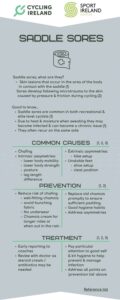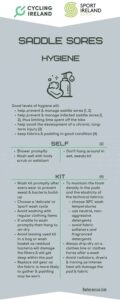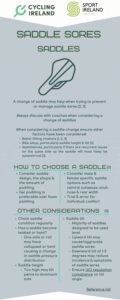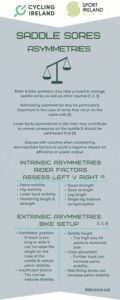Authors: Thomas Fallon (1,2), Eimear Crowley (3), and Paul Carragher (3)
This blog provides education on saddle sores and practical advice to help reduce prevalence in cyclists, from commuters to professionals.
Saddle sores are an underreported problem that many cyclists experience. Saddle sores present as a painful nodule located in the ‘saddle area’ for cyclists which encompasses the inner thighs, perineum, genitals, and buttocks. The true prevalence of saddle sores amongst the cycling population is unknown, mainly due to the lack of prospective injury and illness insight within cycling [1, 2]. Indeed, saddle sores may not only impact the competitive cyclist, the commuter, the weekend recreational cyclist and those who use cycling as a form of occupation may also experience saddle sores. Evidence shows the popularity of cycling is increasing, especially at a population level [3]. Thus, the impact of saddle sores should be considered as they could reduce the overall enjoyment of exercise which in turn may reduce the frequency and duration of participation.This in turn will impact the positive health impact of cycling exercise [4].
As part of surveillance insights gained from Cycling Ireland’s athlete development program over 3 years, one of the most reported “health problems” by junior cyclists was saddle sores or saddle-related discomfort. An athlete ‘health problem’ is defined as “any condition that reduces an athlete’s normal state of full health, irrespective of its consequences on the athlete’s sports participation or performance, or whether the athlete sought medical attention” [5, 6]. As a first step to reducing the prevalence and impact of saddle sores amongst cyclists in Ireland, we created a four-part educational series of infographics to provide practical, basic advice to help raise awareness about the potential causes and prevention strategies for saddle sores. Click here for PDF of below infographic.

This infographic series was developed with multi-disciplinary input from national coaches, performance leads and physiotherapists working within cycling. An initial draft was created with an iterative review process leading to the development of the following infographic series. As a result of this process, three main themes emerged.
Where can we start in getting to the bottom of saddle sores?
Hygiene
- Saddle sores often occur due to moisture built up from prolonged durations of exercise which creates a hot humid environment. Prolonged periods post-exercise sitting in chamois or exercise wear has been associated as a possible cause of such issues.
- Those who cycle as part of their occupation should acknowledge the importance of correctly fitting attire and the influence of prolonged periods between changing clothing. Click here for ‘Hygiene’ infographic PDF.

Addressing asymmetries
- Asymmetries in a cyclist’s body can cause unequal pressure on one side of the saddle, which over time may lead to friction-related issues and the development of saddle sores. Recently, advancements in saddle pressure mapping have allowed bike fitters to identify the main pressure points between the rider’s body and the saddle. This information can be used to make ergonomic adjustments, improving the interface between the cyclist and the bike to prevent such issues.
- Whilst competitive cyclists will be familiar with bike fitting, recreational cyclists may need to be educated that a correct bike set-up can reduce the prevalence of such complaints whilst simultaneously improving their cycling efficiency. Click here for ‘Asymmetries’ infographic PDF.
Saddle choice
- There are hundreds of bike saddles on the market, it is not one size fits all. Often cyclists new to cycling will ride the saddle that came on the bike when they bought it. In the event of early onset saddle-related discomfort, this may be an important consideration.
- There is a range of saddles on the market from sex-specific to discipline-specific. Many saddle brands have test saddles which cyclists can trial from their bike shop before buying to ensure comfort and fit. Click here for ‘Saddle Choice’ infographic PDF.

Conclusion
- Saddle sores are an underreported common cause of saddle-related discomfort in all levels of cyclists, from commuters to professionals.
- Steps such as maintaining good personal hygiene post-exercise, correctly fitting chamois and a correct bike set-up are considered the ‘first line of defence’ in preventing saddle sores.
- Many saddle brands have test saddles which cyclists can trial from their bike shop before buying to ensure comfort and fit.
- Re-occurring complaints of saddle-related discomfort should be discussed with your coach and General Practitioner.
X (Twitter): @TFallon_Physio, @UKCCIIS.
References
[1] Napier D, Heron N. Getting to the Bottom of Saddle Sores: A Scoping Review of the Definition, Prevalence, Management and Prevention of Saddle Sores in Cycling. Int J Environ Res Public Health; 19. Epub ahead of print 30 June 2022. DOI: 10.3390/ijerph19138073.
[2] Bury K, Leavy JE, Lan C, et al. A Saddle sores among female competitive cyclists: A systematic scoping review. J Sci Med Sport 2021; 24: 357–367.
[3] UCI. Spectacular TV and digital audiences for 2023 UCI Cycling World Championships in Glasgow and across Scotland, https://www.uci.org/pressrelease/spectacular-tv-and-digital-audiences-for-2023-uci-cycling-world/3KSV2mdsYiRRoPBupy1tDT (17 October 2023, accessed 8 December 2023).
[4] Logan G, Somers C, Baker G, et al. Benefits, risks, barriers, and facilitators to cycling: a narrative review. Front Sports Act Living; 5. Epub ahead of print 19 September 2023. DOI: 10.3389/fspor.2023.1168357.
[5] Clarsen B, Pluim BM, Moreno-Perez V, et al. Methods for epidemiological studies in competitive cycling: an extension of the IOC consensus statement on methods for recording and reporting of epidemiological data on injury and illness in sport 2020. Br J Sports Med 2021; 55: 1262–1269.
[6] Bahr R, Clarsen B, Derman W, et al. International Olympic Committee consensus statement: methods for recording and reporting of epidemiological data on injury and illness in sport 2020 (including STROBE Extension for Sport Injury and Illness Surveillance (STROBE-SIIS)). Br J Sports Med 2020; 54: 372–389.
Author Affiliations
1 Centre for Public Health, Queen’s University Belfast, Northern Ireland.
2 Edinburgh Sports Medicine Research Network & UK Collaborating Centre on Injury and Illness Prevention in Sport (UKCCIIS), Institute for Sport, PE and Health Sciences, University of Edinburgh.
3 Sport Ireland Institute, National Sports Campus, Abbotstown, Dublin.
